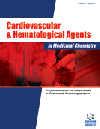- Home
- A-Z Publications
- Cardiovascular & Hematological Agents in Medicinal Chemistry (Formerly Current Medicinal Chemistry - Cardiovascular & Hematological Agents)
- Previous Issues
- Volume 10, Issue 3, 2012
Cardiovascular & Hematological Agents in Medicinal Chemistry (Formerly Current Medicinal Chemistry - Cardiovascular & Hematological Agents) - Volume 10, Issue 3, 2012
Volume 10, Issue 3, 2012
-
-
Diabetic Cardiovascular Disease – AMP-Activated Protein Kinase (AMPK) as a Therapeutic Target
More LessAuthors: Marie-Ann Ewart and Simon KennedyCardiovascular complications are the leading cause of death and morbidity in patients with diabetes; accounting for around 7 out of 10 of all causes of death in this population. Returning patients to normoglycaemia alone has been shown to have little effect on cardiovascular end points, therefore new therapies and strategies are required in order to reduce the incidence and improve outcomes of cardiovascular disease in diabetic i Read More
-
-
-
Diabetic CVD – Soluble Epoxide Hydrolase as A Target
More LessAuthors: Aurelien Lorthioir, Dominique Guerrot, Robinson Joannides and Jeremy BellienThe incidence of cardiovascular diseases remains high in diabetic patients despite the optimization of blood glucose control and the therapeutic management of risk factors. One emerging promising pharmacological approach that may help to prevent the development of diabetic cardiovascular complications is to improve endothelial function through the restoration of the bioavailability of epoxyeicosatrienoic acids Read More
-
-
-
Targeting Mitochondrial Oxidative Stress Through Lipoic Acid Synthase: A Novel Strategy to Manage Diabetic Cardiovascular Disease
More LessMitochondrial oxidative stress is a major etiological factor in the development of cardiovascular disease associated with type 2 diabetes. Hyperglycemia and insulin resistance contribute to the generation of excessive reactive oxygen species (ROS) which have damaging effects on various macromolecules within the mitochondria, leading to mitochondrial dysfunction. Mitochondrial damage within the endothelial cell Read More
-
-
-
Aldose Reductase, Oxidative Stress and Diabetic Cardiovascular Complications
More LessCardiovascular disease represents the major cause of morbidity and mortality in patients with diabetes mellitus. Studies by us and others have implicated increased flux via aldose reductase (AR) as a key player in mediating diabetic complications, including cardiovascular complications. Data suggest that increased flux via AR in diabetics perpetuates increased injury after myocardial infarction, accelerates atherosclerotic Read More
-
-
-
Diabetic CVD – Focus on Vitamin D
More LessAuthors: Shokoufeh Bonakdaran and Haleh RokniCardiovascular disease (CVD) is the leading cause of mortality and morbidity among diabetics. Vitamin D deficiency is very common all over the world. Over last few years, vitamin D has been considered as an important regulating factor for cardiovascular health. Metabolic syndrome and obesity are highly prevalent in vitamin D deficient people. In fact all components of metabolic syndrome are affected by vitamin D. Vita Read More
-
-
-
Active Phytochemicals from Chinese Herbs as Therapeutic Agents for the Heart
More LessAuthors: John Wing Shing Ho, Matt Wan Man Cheung and Vivian Wai Lam YuNaturally occurring plant alkaloids, in particular those identified from herbal medicines, are finding therapeutic use. Heart diseases can be well managed with specific formulations of herbal medicines. The combined action of multiple constituents of herbal medicines works with therapeutic benefits in humans. The established formulations of Traditional Chinese medicines show efficacy in treatment of diseases. However, indi Read More
-
-
-
Update in Pharmacological Management of Coronary No-Reflow Phenomenon
More LessThe no-reflow phenomenon (NRP) is defined as the lack of adequate myocardial tissue perfusion despite a patent epicardial coronary artery. The incidence of NRP varies between 2-5% of elective percutaneous coronary interventions (PCI) and 30% in primary PCI. Clinically, it is an independent predictor of myocardial infarction, in-hospital mortality, and long-term mortality. It may be categorized in interventional (after PCI, espe Read More
-
-
-
On the Role of Endothelial TRPC3 Channels in Endothelial Dysfunction and Cardiovascular Disease
More LessAuthors: K. Smedlund, M. Bah and G. VazquezIn endothelium, calcium (Ca2+) influx through plasma membrane Ca2+-permeable channels plays a fundamental role in several physiological functions and in the pathogenesis of cardiovascular disease. Current knowledge on the influence of Ca2+ influx in signaling events associated to endothelial dysfunction has grown significantly over recent years, particularly after identification of members of the Transient Receptor Read More
-
Volumes & issues
-
Volume 23 (2025)
-
Volume 22 (2024)
-
Volume 21 (2023)
-
Volume 20 (2022)
-
Volume 19 (2021)
-
Volume 18 (2020)
-
Volume 2 (2020)
-
Volume 17 (2019)
-
Volume 16 (2018)
-
Volume 15 (2017)
-
Volume 14 (2016)
-
Volume 13 (2015)
-
Volume 12 (2014)
-
Volume 11 (2013)
-
Volume 10 (2012)
-
Volume 9 (2011)
-
Volume 8 (2010)
-
Volume 7 (2009)
-
Volume 6 (2008)
-
Volume 5 (2007)
-
Volume 4 (2006)
Most Read This Month
Article
content/journals/chamc
Journal
10
5
false
en


